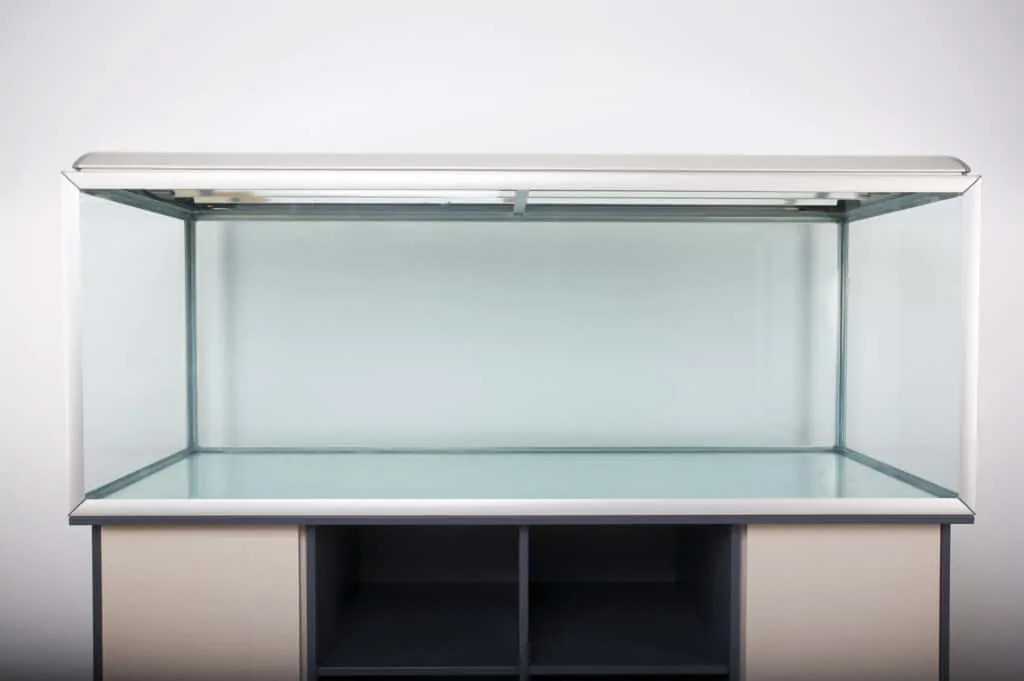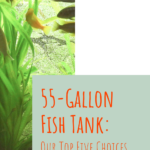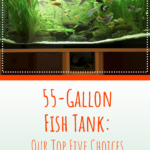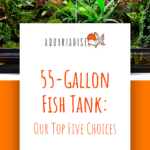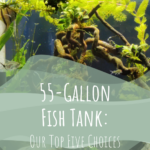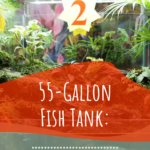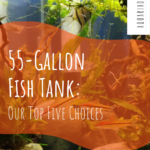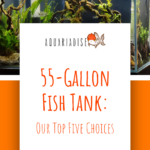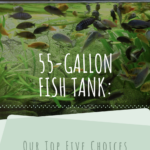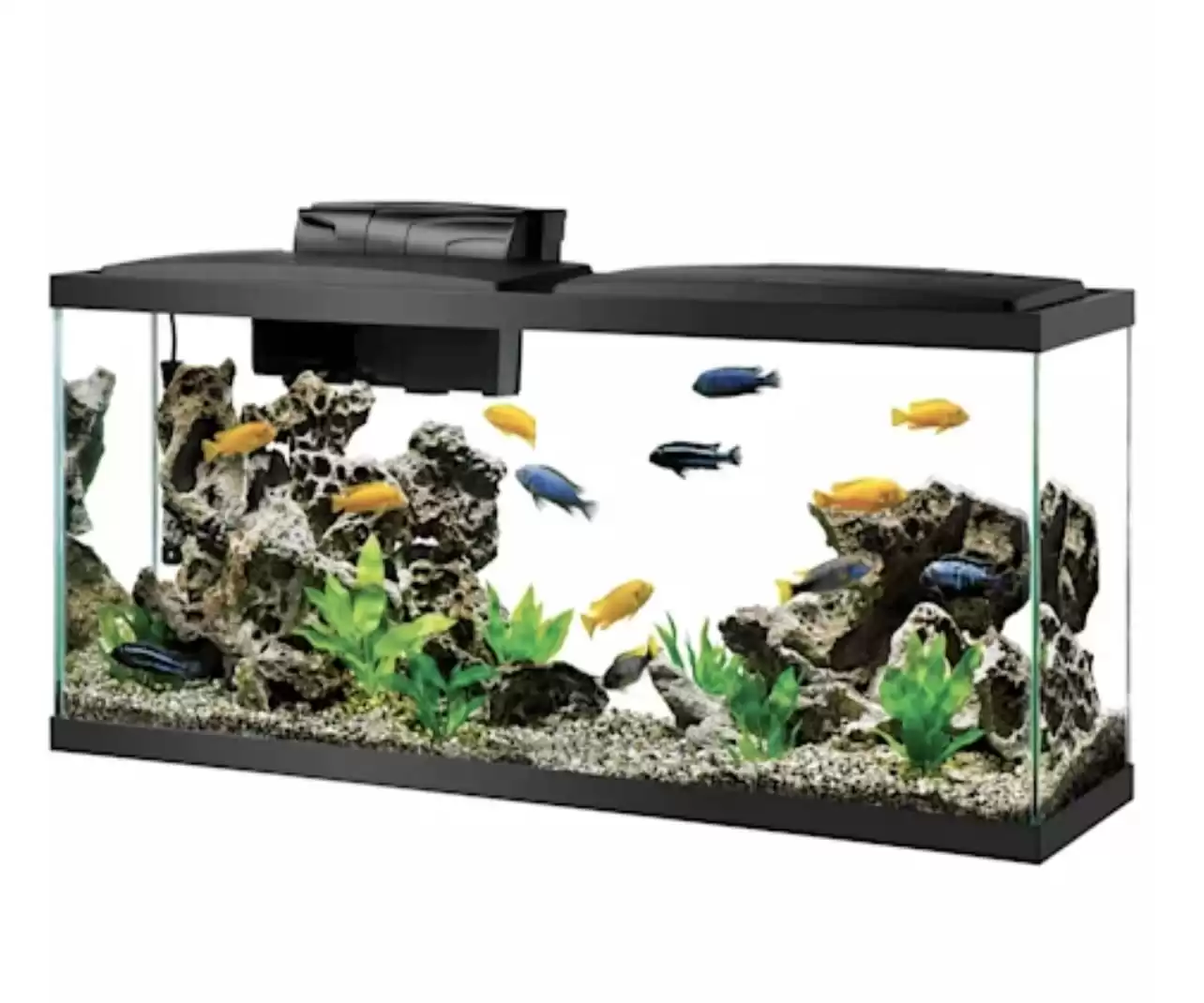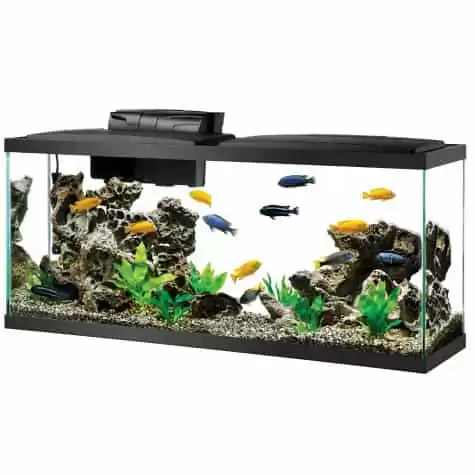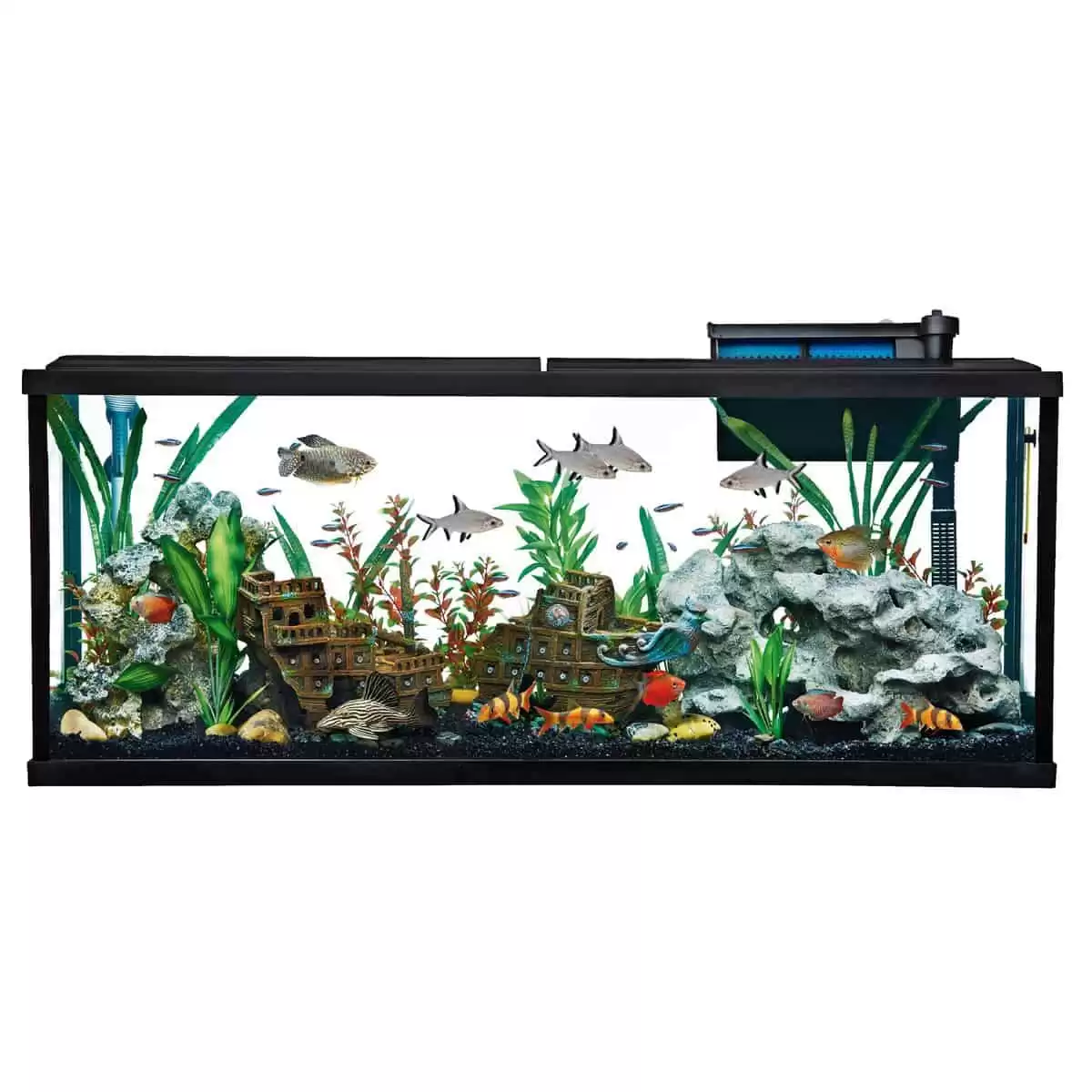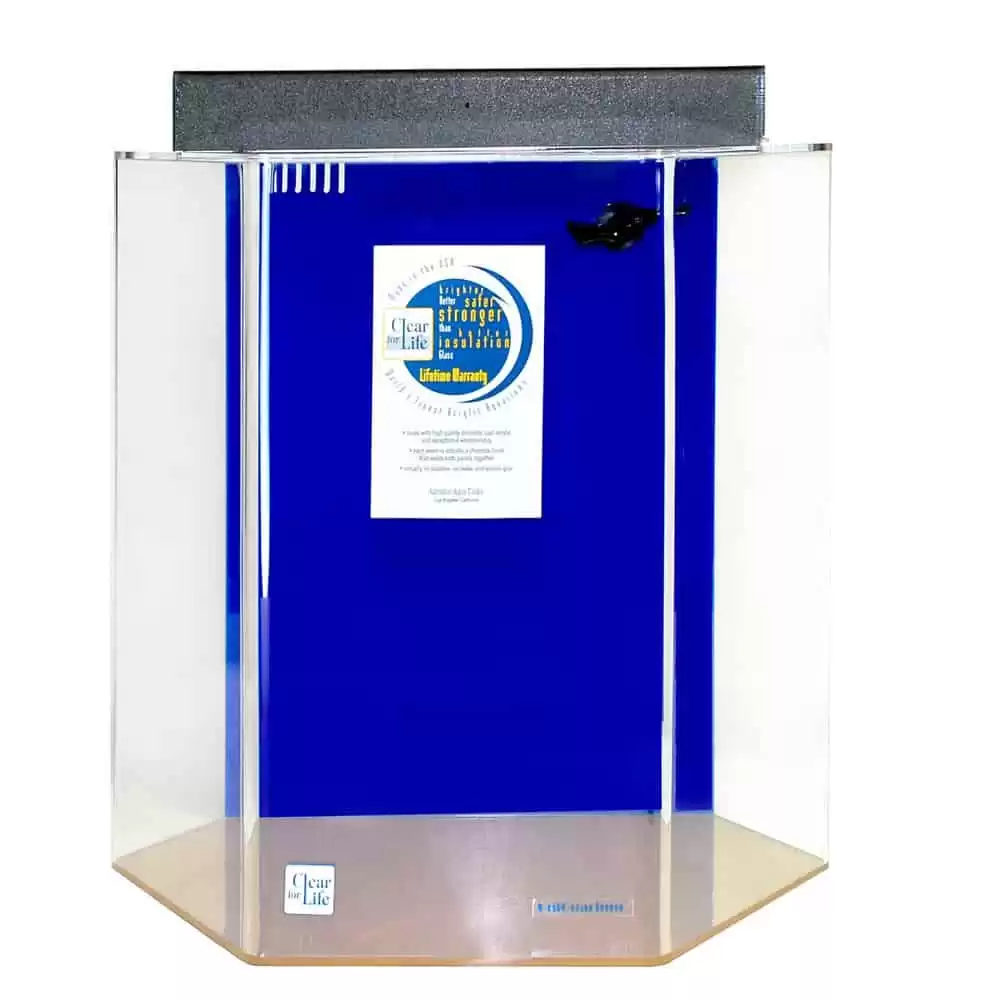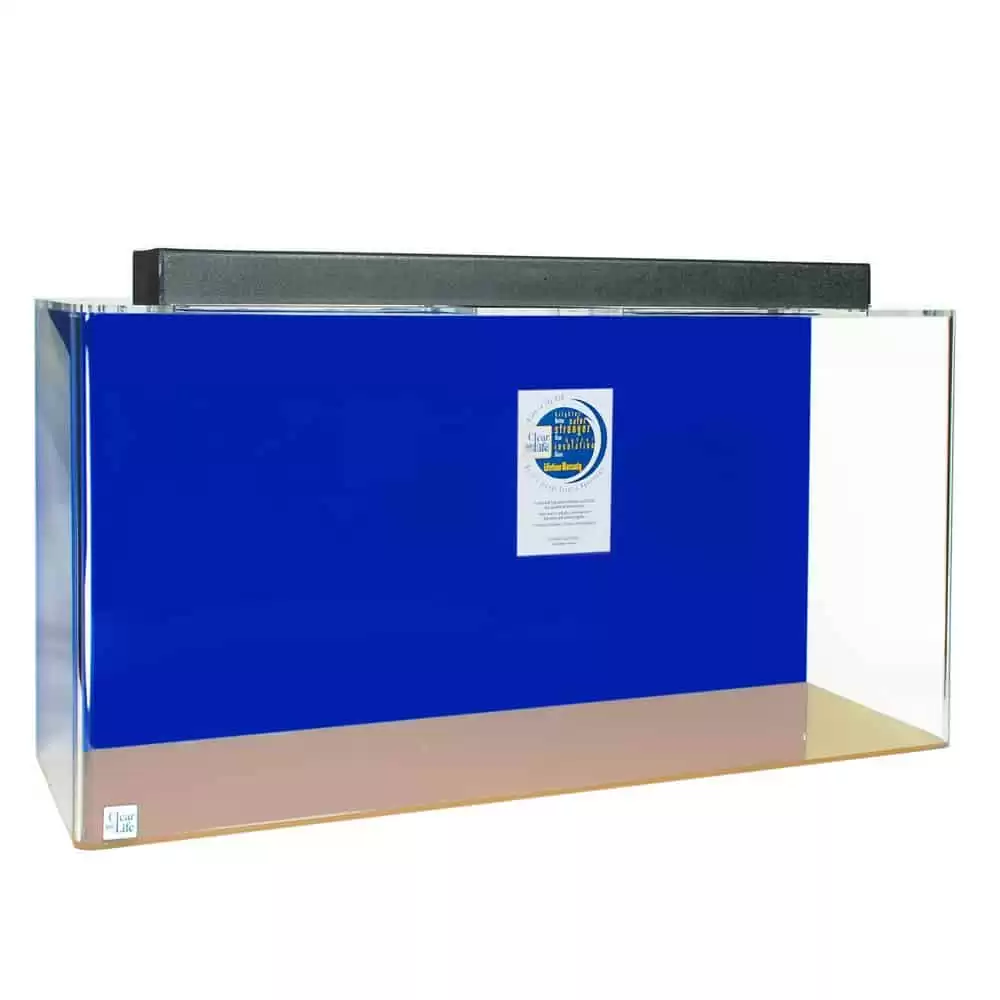There is a good reason why 55-gallon (208.2 L) fish tanks seem to be everywhere in the aquarium hobby; they’re not too big and they’re not too small so they allow for a full range of both marine and freshwater species with the required equipment and products being easy to find.
If you’re serious about setting up a mini-ecosystem in your home, a 55-gallon aquarium will give you the space you need while still being a manageable size for easy maintenance.
Keep reading to find out everything you need to know about 55-gallon aquarium systems and our top 5 choices!
Why Bigger Is Better
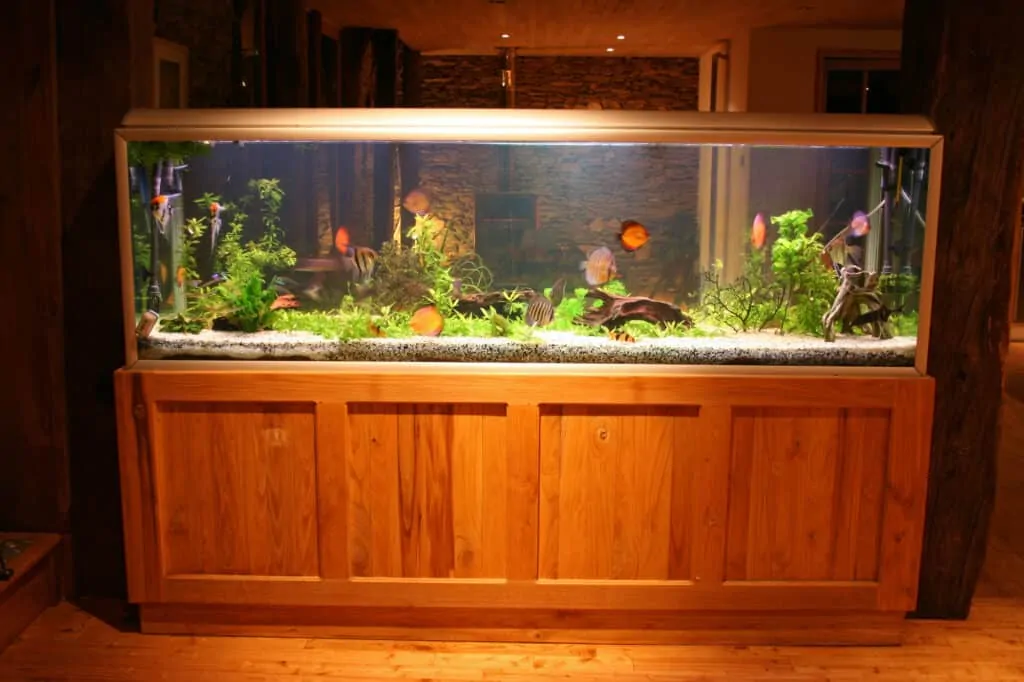
Most times, hobbyists that are just starting out are told to get as big of a fish tank as they can. Why is that? Not only do larger tanks allow for more fish, but they actually make setting up and maintaining your aquarium easier in the long run.
A 55-gallon fish tank is enough space to house a considerable amount of fish. Most hobbyists starting out don’t realize that smaller tanks quickly run out of space due to schooling needs or to allow for aggression. A 55-gallon tank can accommodate several schools of freshwater fish or house an assortment of saltwater fish. While there are still some species that need bigger tanks, for the most part, there is a large selection available for this size.
On top of this, most hobbyists find themselves wanting to upgrade within a matter of months of setting up their first tank. Whether it’s because the tank doesn’t allow for the desired aquascape or the combination of livestock, many fishkeepers make at least one upgrade throughout their time in the hobby; otherwise, the rest just end up setting up a new tank altogether!
More importantly, 55-gallon fish tanks are easier to monitor than smaller tanks. This is simply due to the fact that the water volume is greater and small fluctuations have less of an impact; for example, if one of the snails in your tank dies, it is not likely that there will be a detectable spike in ammonia. This is because the ratio of ammonia to water volume is that much greater than in smaller tanks. This example also relates to most other important parameters as well, including temperature and salinity.
|
4.4
|
4.0
|
4.0
|
55-Gallon Fish Tank Maintenance
A larger tank might seem intimidating to take care of, but since these tanks allow for so much beneficial bacteria to grow and parameters eventually tend to stabilize themselves, 55-gallon fish tanks usually require less maintenance than smaller tanks overall. Again, this is due to the water volume ratio with respect to wastes and other detritus.
The two main methods of maintenance for the success of your 55-gallon fish tank are regular water changes and equipment upkeep.
Water Changes
Every tank is different; some might need a water change weekly, while others might not need a water change at all! In order to find out how often you need to do a water change, you will need to keep track of nutrient import and export from your tank.
While most hobbyists agree that ‘perfect’ numbers exist in the aquarium, stability is more important and will lead to a thriving ecosystem. That being said, hobbyists aim for 0 ppm ammonia, 0 ppm nitrite, and <10 ppm nitrate for both freshwater and saltwater systems; trace element values, like phosphate and calcium, vary depending on the type of tank being run.
It is best to do a water change when these levels are close to exceeding these ideal limits; ammonia and nitrite especially need to be kept at 0 ppm as they become harmful at any amount.
Along with removing these values from the tank, water changes also help bring in new minerals and nutrients. New water is oxygenated and full of trace elements that usually become depleted over time in your tank. For saltwater tanks, water changes and regular top-offs also help with maintaining salinity levels.
Water changes are also a good time to vacuum the substrate and waft dead zones throughout the tank. Waste that sits in the substrate can lead to excess nitrates and phosphates, and can even create anoxic areas within the sandbed. Detritus that sits on decorations or rocks can also lead to excess nutrients and will create a foundation for algae to flourish.
Equipment Upkeep
Regular filter upkeep is also important to ensure that everything stays working properly in your aquarium.
Filter media needs to be replaced on a timed schedule as their efficacy runs out and some can actually lead to additional problems if left unchanged. The entire filter should also be regularly cleaned as a lot of detritus tends to build up at the bottom. For sumps, filter socks should regularly be washed and replaced when needed.
It is best to clean all other aquarium equipment on a regular basis as well in order to make sure that they are still working at full capacity and that nothing is getting clogged. This includes powerheads, heaters, CO2 systems, auto top-off systems, and any other mechanical equipment that is helping run the system.
Other equipment, like refractometers and thermometers, should also be tested regularly and recalibrated when needed. It is very easy to think that there is something wrong in your tank due to a bad reading when it is actually due to faulty and/or uncalibrated equipment!
55-Gallon Aquarium Stocking Ideas
A 55-gallon fish tank can accommodate a lot of fish, but as with any aquarium, planning out livestock is the trick to making your mini-ecosystem work.
For example, you won’t want to start with predatory fish, and then, later on, add community fish; you will quickly end up right back at having just a predatory tank!
First, you will need to decide if you want to have a freshwater or saltwater system, as laying the foundations for both require some planning as well.
Freshwater tanks are generally considered easier than saltwater tanks and can be done in almost any aquarium size; most hobbyists recommend at least 55 gallons for those just starting out with saltwater fish.
Freshwater Setup
If planning on keeping freshwater fish, you will first need to decide if you want to keep aggressive or community fish.
Aggressive fish tend to be larger and exhibit more interesting behaviors while community fish usually need schools and stay small. In general, aggressive tanks will have less fish than community tanks.
Regardless of what kind of freshwater fish tank setup you go with, here is a list of equipment you will need to keep your ecosystem thriving in the long run:
Recommended Freshwater Equipment
Though freshwater tanks might be easier to keep than saltwater tanks, they still require adequate filtration, water flow, a heater, and other decor and accessories.
Filtration
Most freshwater tanks do best with an easy hang-on-back (HOB) filter or canister filter; some hobbyists use sumps, though they tend to be more favored for saltwater setups.
It is recommended that this filter is rated for at least double the size of the tank, so for a 55-gallon fish tank, a filter rated for at least 110 gallons (416.4 L) should be enough; it may also be worth considering purchasing two separate filters rated for 55 gallons each and placing them on opposite ends of the tank.
It is important to note that predatory fish tend to be messier eaters than community fish, and leftover fish food may need to be manually removed. For smaller tanks, some hobbyists choose to use sponge filters instead or rely on live plants to handle the bioload.
Water Flow
Water flow in freshwater fish tanks isn’t as demanding as in saltwater tanks, but you still need to keep an eye out for dead zones where water becomes stagnant.
By having two filters on each side of the tank, you will help create a more even flow throughout all areas of the aquarium. If you’re still struggling with getting water moving in specific areas, it may be worthwhile to purchase a powerhead.
Heater
Whether you’re setting up a predatory or community fish tank, a heater is usually a must; most of the fish in the aquarium trade come from tropical waters and need a stable and constant temperature. Very few fish, like goldfish and white cloud mountain minnows, thrive at lower water temperatures and don’t need a heater.
In general, water temperature needs to be maintained between 72-82° F (22.2-27.8° C); it is important to make sure you understand the preferred water temperature of each fish you add as some might do better at the lower or higher ends of that spectrum.
Freshwater fish tend to have a much broader water temperature range overall than saltwater fish, but each species still has an ideal climate that needs to be met.
Other decor and accessories
While filtration, water flow, and a heater are the basis for making a fish tank run, there are a few other accessories that will make your freshwater tank the best that it can be.
Some additional items you will need are a thermometer, substrate, decorations, and lighting. A CO2 system and mineral/nutrient supplements might also be necessary depending on if the aquarium will have live plants.
Saltwater Setup
Like freshwater aquariums, you will need to decide if you want to have a predatory or community saltwater fish tank.
Overall, saltwater fish are much more aggressive and need to be able to set up separate territories more than freshwater fish, meaning that you are more limited in the species you can pick and how many fish you can have.
On top of that, not many saltwater fish are known for schooling, though some, like the clownfish, will pair off and stick together as they move throughout the tank.
Regardless of what kind of saltwater fish tank setup you go with, here is a list of equipment you will need to keep your ecosystem thriving in the long run:
Recommended Saltwater Equipment
The recommended equipment for saltwater fish tanks is similar to that for freshwater but usually needs to be a little more efficient and precise.
To start, you will need good filtration, water flow, a heater, a refractometer, as well as other decor and accessories.
Filtration
In saltwater tanks especially, filtration is seen as more than just a means to remove waste. Most saltwater filtration systems include several methods of mechanical filtration, chemical filtration, and a sizeable space for biological filtration. Because filtration is so important for saltwater systems, sumps are usually the preferred setup, though hobbyists still often use hang-on-back (HOB) filters and canister filters with success.
However, sumps allow for a lot of extra space that is needed for beneficial bacteria to live, as well as to store other bulky equipment like protein skimmers, heaters, and even auto top-off (ATO) systems. Some hobbyists even dedicate chambers to refugiums for additional nutrient export.
Water Flow
Water flow is critical in saltwater fish tanks. Water movement helps with gas exchange and prevents detritus from building up; gas exchange is especially important if you’re planning on keeping corals. When cut off from sufficient water flow, saltwater fish and coral will suffer and quickly die as gas exchange becomes inadequate.
This is why air stones are completely essential if you’re planning on setting up a fish tank as they will keep oxygen flowing into your tank even if the power goes out.
Heater
Saltwater fish can be hardy, but usually not as hardy as freshwater fish when it comes to water temperature. When it comes to keeping corals, 78° F(25.6° C) is the ideal temperature; even one- or two-degree fluctuations can be enough to upset the most sensitive corals, like Acropora. A good-quality and adjustable heater is a must if planning on starting a saltwater tank.
Most saltwater fish will be able to withstand some deviation from that ideal, though they are usually less able to adapt to sudden water parameter changes as a whole.
Refractometer
A refractometer is a must for saltwater fish tanks.
Refractometers are simple and easy-to-read pieces of equipment that display the salinity of your tank by measuring the extent of light refraction in your water sample. Simply put, refractometers will allow you to mix saltwater and keep your saltwater fish tank at the appropriate salinity level, aiming to stay around 1.025-1.026 (34-35 ppt).
There are a few different refractometers available today, with each differing in accuracy and ease of reading. The two best products are either a handheld refractometer or a digital refractometer (or both!).
Other Decor and Accessories
Saltwater fish tanks are considerably more expensive to set up than freshwater systems. This is because the equipment is usually a higher grade of quality and there are more necessary decor and accessories.
Like a freshwater tank, a saltwater tank also needs a thermometer, substrate, decorations, and lighting.
However, a saltwater fish tank will also need porous live rock for bacteria to grow and populate. Lighting fixtures will be one of the most expensive purchases for your saltwater tank, especially if you plan on keeping coral. On top of that, additional mineral/nutrient supplements might be needed to keep coral thriving.
As we mentioned before, an air stone is always an easy solution to a temporary blackout. Experienced hobbyists usually purchase a generator just for their tank in case the power goes out as saltwater tanks can easily get to cost thousands of dollars in livestock!
Our Top 5 Choices
Now that we’ve covered what it takes to run a 55-gallon tank, now it is time to find out everything you need to consider before actually going out and bringing your tank home.
Here is our list of the best 55-gallon fish tank setups available today based on quality, customizability, design, and customer reviews!
Aqueon Standard Glass Aquarium Tank 55 Gallon
- High quality glass construction
- Clean silicone edges
- For freshwater and marine applications
If you’re looking for a simple glass tank to build off of and customize, the Aqueon Standard Glass Aquarium Tank 55 Gallon is just what you need. These glass tanks measure 48.75 L x 21.25 W x 14.00 H inches (123.8 L x 54.00 W x 35.56 H cm) and provide the blueprint you need to cultivate saltwater or a freshwater ecosystem.
Designed with a classic black rim and clean silicone edges, these tanks can accommodate a variety of species, biomes, filtration, and equipment; only the glass tank is included, other accessories and a stand will need to be purchased separately. Some customers have had difficulty with the limited width, silicone application, and glass panel alignment.
What we like:
- Good blueprint for different tank setups
- Standard dimensions
Room for improvement:
- Limited width
- Some problems with silicone application and/or glass panel alignment
- No additional equipment included
Clear-For-Life 55 Gallon Hexagon UniQuarium
- Built-in filtration to keep your water quality in pristine condition.
- Acrylic aquariums are brighter, safer, and stronger than glass to protect your fish from temperature fluctuations.
- These aquariums are the perfect choice for freshwater, marine, reef or planted aquarium setups.
The Clear-For-Life 55 Gallon Hexagon UniQuarium is more for aesthetics than practicality but might be just what you’re looking for to fill that empty space in your room. These unique acrylics tanks measure 29 L x 25 W x 24 H inches (74 L x 64 W x 61 H cm) and are cut into a hexagon. Acrylic is primarily used for better clarity and durability but has the downside of being easily scratched.
These hexagonal tanks feature an internal filtration compartment, ready for mechanical, chemical, and biological filtration. This filter draws water in through intake slots, drains it through your choice of media (sponge, floss, carbon, etc.), through biological media (bioballs, live rock, etc.), and is then returned via a mechanical pump and clear airline tubing. These fish tanks are also designed with seamless, heat-fused acrylic that has been shaped to form a lid. A fluorescent light fixture is included, though the bulb is usually not; an aquarium stand is also not included.
Oddly-shaped tanks aren’t preferred by most hobbyists. Even flow throughout the whole aquarium can be difficult to achieve and cleaning can be a nightmare; especially with this specific acrylic aquarium, the limited access to the tank via the fused lid makes the process even more difficult. Other problems with an oddly-shaped tank include finding equipment that properly fits, horizontal versus vertical swimming space, and physical placement in the room. However, a hexagonal tank can be a great showpiece for certain species, like seahorses, and can make or break the atmosphere of a room.
What we like:
- Acrylic aquarium with clean and seamless hexagonal design
- Internal filtration
- Optimal for specific species, like seahorses
Room for improvement:
- Limited access to the interior of the tank due to sealed lid
- Limited filtration space; basic filter equipment/media
- Lighting and stand not included
Clear-For-Life 55 Gallon Rectangle Aquarium
- Acrylic aquariums are brighter, safer, and stronger than glass.
- Better insulator to protect your fish from temperature fluctuations.
- Comes with a Limited Lifetime warranty against leakage.
- Perfect choice for freshwater, marine, reef, or planted aquarium setups.
If you like the quality of the Clear-For-Life 55 Gallon Hexagon UniQuarium but want a more traditionally-shaped acrylic aquarium, the Clear-For-Life 55 Gallon Rectangle Aquarium might be a better fit. As mentioned before, an acrylic aquarium will offer a clearer view and more durable construction than a glass tank but will scratch easier.
These fish tanks measure 48 L x 13 W x 20 H inches (122 L x 33 W x 51 H cm) and come in the standard rectangular size with Sapphire Blue backdrop. They have been designed for a seamless, heat-fused look that continues onto the lid; cut-outs are allowed for various aquarium equipment and for access to the tank. A fluorescent light fixture is included, though the bulb will need to be purchased separately. An aquarium stand is also not included.
What we like:
- Standard dimensions with quality acrylic design
- Bright Sapphire Blue backdrop
Room for improvement:
- Limited access to the interior of the tank
- Lighting and aquarium stand not included
Aqueon 55 Gallon LED Aquarium Kit
- Cool White LED Energy Efficient Lighting
- Sleek, Low Profile Hood
- Energy Saving
The Aqueon 55 Gallon LED Aquarium Kit is a popular choice for many hobbyists as it is usually easy to find and marked at an affordable price. These glass aquariums measure 55.38 L x 22.63 W x 14.50 H inches (140.67 L x 57.5 W x 36.83 H cm) and include almost everything needed to set up and support a basic ecosystem.
This kit comes with the glass tank, QuietFlow 75 Power Filter (approximately 400 GPH), filter cartridges, submersible preset heater, fish food sample, water conditioner sample, fish net, external thermometer, setup guide, and two low profile aquarium hoods with pre-installed LED lighting; these lights only include energy-efficient white modules, which can be used for some plants and corals with caution. The hoods are designed with cutout holes for feeding and equipment, though salt creep and condensation can become a problem if left unmonitored. An aquarium stand is not included.
Customer reviews have found that the included equipment is a little weak for the usual stocking of a 55-gallon fish tank; the external thermometer is also of little to no use. Most likely, you will need to upgrade the filtration and heater on this tank in exchange for an adjustable heater for better temperature control.
What we like:
- All-in-one, inexpensive, and quality construction
- Bright and energy-efficient LED lighting that can support some plants and corals
- Included hoods to reduce water evaporation
- Some included water conditioner and fish food samples, as well as a fish net to get started
Room for improvement:
- LED lighting only emits a white spectrum
- The hoods are poorly designed to handle evaporation and salt creep
- Some reviews have stated poor silicone coverage/application
Top Fin® Essentials Aquarium Starter Kit
- 55 Gallon Glass Tank With Hood
- Bright White LED
- Water Test Vial
Similar to the Aqueon 55 Gallon LED Aquarium Kit, the Top Fin® Essentials Aquarium Starter Kit is an even less expensive option. These glass tanks measure 48 L x 13 W x 20 H inches (122 L x 33 W x 51 H cm), which is taller than the Aqueon kit but comes as an exchange for less width and length.
This glass aquarium kit includes a 200 W adjustable heater, two aquarium hoods with pre-cut feeding holes, two LED light strips, an internal thermometer, a water test bottle, Top Fin® Silenstream PF75 Power Filter, filter media, and a fish net. An aquarium stand is not included.
Customers have found the construction of the tank to be above average, with very thick glass panels. However, the aquarium hoods do not allow too much space to access the tank and the hoods can be difficult to set firmly in place. Many hobbyists have also found themselves needing to upgrade the filtration shortly after purchasing the kit as the included filter is a little weak for the bioload of an average 55 gallon tank. Added benefits are an adjustable heater and an internal thermometer.
What we like:
- Quality construction of the glass tank
- Included adjustable heater and internal thermometer
- Bright LED lighting that can support some plants
Room for improvement:
- Limited width and height dimensions
- Poor filter/hood quality
Conclusion
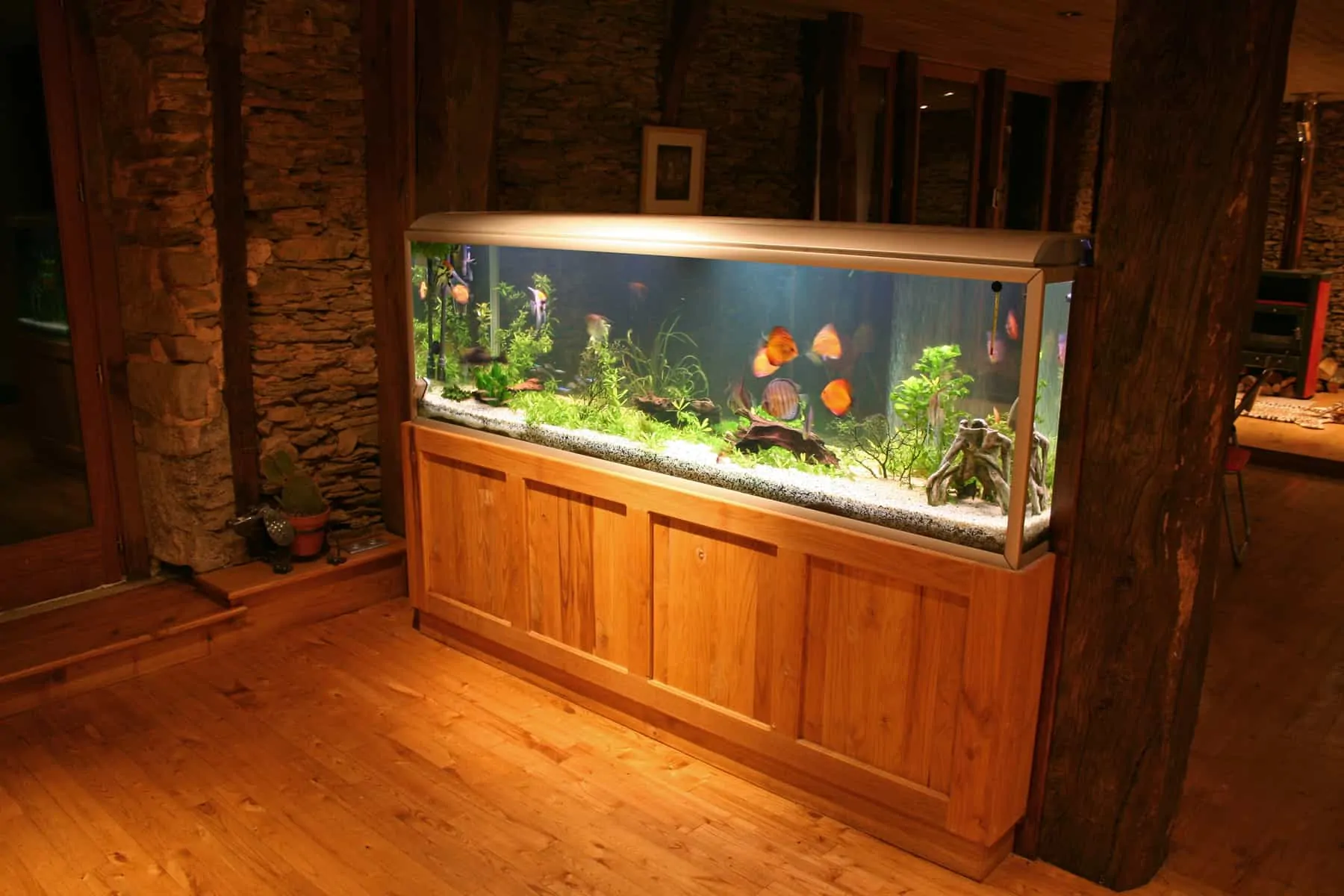
55-gallon fish tanks are one of the best sizes that beginner hobbyists can get; their water volume prevents large parameter fluctuations while their blueprint allows for an assortment of species and specific biotopes.
Most 55-gallon fish tanks come in a standard size and are easy-to-find properly fitting equipment that might be more specialized for oddly-sized aquariums.
Because these aquariums are such a standard size, there are a lot of similarities between products. However, it is best to find the one that fits everything you’re looking for as startup expenses for a 55-gallon tank can be a little more than you might first expect!
If you have any questions about larger tanks, the difference between an acrylic or glass tank, the best species for a 55-gallon tank, or have had experience with this size tank, don’t hesitate to leave a comment below!

